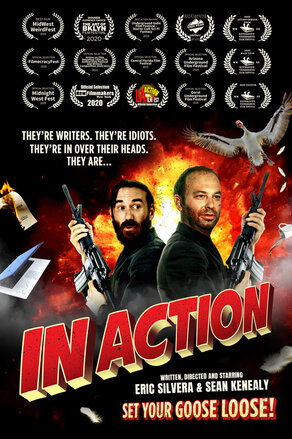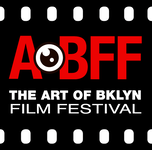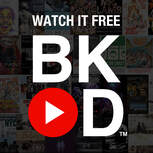|
Filmmakers Eric Silvera and Sean Kenealy co-wrote, co-directed and co-starred in "The World's First Two-Person Action Movie" IN ACTION. The feature had its East Coast Premiere at the Art of Brooklyn Film Festival's 2020 Digital Edition, taking home the coveted Audience Choice award. The film's successful festival run led to a distribution deal with Gravitas Ventures. AoBFF's own Jake King had some questions for Eric and Sean on the devotion to take this unique film from concept through production, how they built their audience, advice for filmmakers, and much more. 
IN ACTION has a very interesting production journey. We’re still impressed by how you made it. Can you tell the story?
Eric: In early 2014, Sean and I sat in a pizza joint near Union Square brainstorming ideas for our next project. Sean pitched: “I want to make a feature-length action movie with two people sitting in chairs talking to each other for $5,000.” I said, “I don’t know what that means.” “We can use fast-paced dialogue, and descriptions of what’s happening, and quick cutting to make it feel like it’s action packed, even though it’s just us sitting in chairs. We’ll call it How To Write and Star in Your Own Action Movie.” I was intrigued. Then Sean added, “We have no Hollywood connections, and any other script we write is just going to sit in the slush pile. You do stand-up so you can perform, I act, we both write, and you studied film in college. Let’s make something that can’t be ignored.” Later, I walked through the East Village and kept picturing a car chase with two people sitting in chairs. If the camera was constantly moving, roving around the chairs, and there was quick cutting, strong sound design, and we took the scene seriously, maybe it could feeeeeeeel like a car chase. I was in. We made a list of action tropes we’d embrace: a mismatched heroic duo, core eccentric villains with generic henchman, one-liners, and over-the-top violence. But what about the story? We agreed it was best to develop a storyline for an actual movie and ignore the two-person premise during this process. The plot: Two idiots writing an action screenplay get flagged by the government based on the content of their emailed plot ideas, and uncover a giant conspiracy. We wrote for several months, and, once satisfied with a draft performed live readings in my apartment to understand what did and didn’t work. We also hoped to entice potential producers we invited during these sessions, but no producer fully committed... We then decided to film a reading of the script as a prototype to prove the idea played. Over a single day, and using two camera operators and a sound person, we shot the original premise: An Action Movie With Two People Sitting In Chairs In One Room. Sean edited the prototype. Turns out, it didn’t fully work…but there were a few scenes where the idea truly coalesced. Sean cut a short trailer from those moments and we used that trailer to get our producer, Alex Nordenson, on board. While he hadn’t produced movies, he was a producer at an ad agency and understood the intricacies of production, shoots, and the creative process. Alex was instrumental in getting the film made, the consigliere throughout production process. The prototype taught us that for the Two-Person Action Movie premise to work, it had to evolve into something more cinematic. Two actors, in limited locations, on a tiny budget was still the goal. However, we revised the script to show more, tell less, and pinpointed sections that could use mixed media (animation, hand-drawings, etc.) to enhance action sequences. The revised draft, evolved concept, and prototype trailer were enough to excite some core crew members to join the production. We raised funding via Kickstarter waaayyyy back in Summer 2015 and shot the film on weekends, between the summers of 2016 and 2017 (we had to break for a long period because my second child was born and then my wife had a nearly fatal case of sinusitis). We used two locations for the shoots. Acts 1 and 3 were shot in the small office of my day job. My VP of Sales and CEO allowed us to shoot on the weekends for free, “as long as everything was back to normal by Monday A.M.” This saved so much money, and we converted the office into a wedding reception, a bar, a hotel room, a supermarket, living rooms, a “highway car chase”. Plus, it had bathrooms, a kitchen, offices, and a conference room, all location types needed for the script. For Act 2, Sean found a 750-square foot photo studio in Long Island City, Queens off Craig’s List. It was cheap, grungy, and could be transformed into the various settings of the Underground Lair where our characters are held hostage. Our D.P., Mateo Marquez, did an awesome job figuring out how to shoot and light the scenes within these tight parameters so that each setting felt different, even if we were just redressing the location. During post-production, our editor, Billy Nawrocki, became a core member of the team, eventually also taking on the role of post-production coordinator. We gave him the note, “Imagine if My Dinner Andre was edited like a Michael Bay film” and he ran with it. His work is a major reason the concept of this film was pulled off; Billy’s editing has been singled out in reviews and won/was nominated for Best Editing at several festivals. All in, the film was a six year journey from idea to post-production, made patiently on the side while Sean and I worked full-time, non-entertainment industry careers, raised families, and had a couple nervous breakdowns. In addition to playing the leads, you both co-wrote and co-directed the film. What was that experience like, and do you have any advice for directors working together? Eric: Sean and I have a great partnership and we really lean on each other’s strengths. As writers, we’ve developed a good system of how to approach a project. Generally, over a series of conversations (and then random texts with ideas) we develop the overall story and map out the major beats/themes/plot points. Then, Sean writes first. He has an incredible ability to turn out pages quite quickly and that gets things moving. I have an incredible ability to overthink and analyze so if we waited for me to start a script, we’d still be staring at a blank screen. Once Sean sends me the pages, I begin to edit and also build upon ideas that are in the story. Then I send Sean the revisions and he starts to revise and build. It comes back to me and the process continues. By the time we get to the end of an Act, it’s like multiple drafts have been written, and the screenplay has become a mind-meld between both of our ideas/visions. As directors, we both work really hard to listen to each other and be respectful of the other’s opinions, even when we totally disagree. My wife watched us have an “argument” on set one day and couldn’t believe how calmly we sorted it out. She’s remarked that we’re like a very well-functioning married couple, and if marriages approached an argument this way, there’d never be divorce. Hahaha. Our advice for other directors working together:
There are many fun and interesting scenes in IN ACTION. Were there any particular influences in regards to films or filmmakers?
Eric: We were influenced (and stole) from a lot of different kind of movies. From an action movie standpoint, we really pulled from the tropes of the 80s/90s heyday - flicks like Commando, Predator, Die Hard, Lethal Weapon 1 & 2, The Rock, etc. to both develop the plot and lovingly poke fun at. However, this is a movie that’s basically two people talking to each other the whole time, so we also referenced My Dinner With Andre, Creep, and a lot of Richard Linklater’s work (Tape, the Before Series, Slacker) - films that are dialogue-heavy with limited casts. Then we edited these talky scenes like it was a Michael Bay movie, hahaha. There were truly a lot of disparate influences that we used for specific scenes: a single-take POV fight was inspired by the Ordinary World scene in Layer Cake, while scenes that take place in a therapist’s office were inspired by the interstitials of couples chatting in When Harry Met Sally. Recently, we’ve started telling people that In Action kind of a mix of John McTiernan meets Richard Linklater meets What The Hell Happened To Me-era Adam Sandler/early-Kevin Smith with a dash of the ZAZ comedies. The film won Audience Choice for our 10th Anniversary edition in 2020. Did you have a plan in place to involve your networks to watch and vote? Sean: Definitely. We started with our core team and brainstormed different communities we could reach out to. Friends and family were the obvious ones, but we also contacted coworkers, creative circles, and basically anyone we could think of! We also tried to be purposeful with how we timed all of our outreach. Sending an email or posting on social media every day with the same details will get boring fast. So we spaced it out and included new info with each post/email, such as reviews or write ups from smaller blogs and newspapers. We encouraged our communities/crew to share details on the movie as well. The In Action team only knows so many people, so we really leaned on our friends and family to spread info on our behalf, which was a BIG help. And with all of our outreach, we made sure to include specifics on the Audience Choice Award and how to vote! How early in the filmmaking process did you start to cultivate fans? Any advice for other filmmakers on how to create audience interest? Sean: Honestly, we didn’t really start to cultivate fans until Art of Brooklyn. Up until that festival, no one outside of our team (or other festivals we applied to) had access to watch our movie. AoBFF was the first time we could encourage everyone we know to watch - especially with the festival being online. That said, people definitely knew our movie existed, but a lot of folks didn’t know what stage we were at. AoBFF solidified we were a “real” movie to a lot of our community, and it helped us start to make a fanbase. As for advice, I’d say just keep people posted on what you’re doing with your movie - from pre-production to finished product. Sharing clips, pictures, news, or anything else relevant keeps your movie on people’s mind. They might not be able actually watch your movie yet, but when it DOES become available it’ll be good for them to already know a bit of your backstory. IN ACTION recently scored distribution with Gravitas Ventures — an amazing achievement! Can you tell us how that came about? Sean: Eric and I didn’t have a huge film community when we started In Action. We definitely didn’t know any agents or have any leads with distribution companies. So playing at festivals is what helped get us attention. Right after Art of BK, a producers rep reached out to us offering to help find us distribution. This was a very windy 6 month journey filled with rejection, dozens upon dozens of phone calls, redesigning our poster (then redesigning it again…), but it was the beginning of us landing a deal with Gravitas. What advice do you have for filmmakers in regard to submitting to festivals, as well as promoting your film? Eric: Treat the festival submission process like you’re applying to college. So build a list of your reaches, your “This feels like I have a good shot and would be happy there” and your safety schools. The key to doing this: understanding the genre your film fits into (if it’s easily definable). Then researching festivals that focus on that genre first and if they’ve accepted films in the past similar to yours. If so, what other festivals did those films show at? Then you can begin to build a list of festivals that probably make the most sense and expand outwards/broader from there. We used FilmFreeway often to get a sense of other filmmakers’ experiences, the history of the festival, their requirements, etc. There are so many festivals to choose from, but FilmFreeway is a good way to sort through them. Entry-fees add up quickly so have a good sense of your festival application budget and if it’s limited be discerning. But at the same time, take a few chances - AoBFF was a reach for our no-budget, weird concept-of-a-film, but we were accepted and it opened the path to eventual distribution. Promoting — emails, social media, texting your friends, whatever platform or research you need to do to get the word out, do it. Be nice to friends and family now because they’ll come through for you and help too years later when your film is released. Once your film finds distribution and will be released, consider hiring an (affordable) publicist who can help seed your movie across different media sources that you’ll have no access to on your own. A filmmaker friend thought PR was useless until it helped their small, indie debut receive a review from The New Yorker, which led to a Hollywood gig. 2020 was our first-ever Digital Edition. It was a very different experience but we were thrilled with the results. What was it like having your festival run during lockdown? Sean: This was our first festival run. Eric and I were able to go to one in-person festival (which happened the week before the world shut down in March 2020), and the rest were online. Of course, it would have been amazing to meet more people in person (and to see our movie on the big screen as opposed TVs/laptops!), but festivals like AoBFF did an incredible job of keeping the energy exciting and hosting networking events while being fully online. Being online also pushed us to share our movie with EVERYONE we know. Sure, it would have been amazing to show in Brooklyn, but if we had, then we wouldn’t have reached out to so many people out of state to watch. Online festivals definitely gave us a bigger audience, and in the long run I think it made us focus more on marketing and building a fanbase. Do you have any future projects in development that audiences can look forward to? Sean: We’re currently talking to producers about our next horror-comedy feature called Reject. It takes place in the festival world (not too outside the box of AoBFF…). Hopefully we can share more soon! Get the latest news from The Art of Brooklyn and Brooklyn On Demand!
|
Categories
All
Archives
June 2024
|


 RSS Feed
RSS Feed


